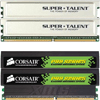- Qualcomm Launches Snapdragon 4 Gen 2 Mobile Platform
- AMD Launches Ryzen PRO 7000 Series Mobile & Desktop Platform
- Intel Launches Sleek Single-Slot Arc Pro A60 Workstation Graphics Card
- NVIDIA Announces Latest Ada Lovelace Additions: GeForce RTX 4060 Ti & RTX 4060
- Maxon Redshift With AMD Radeon GPU Rendering Support Now Available
4GB Trials and Tribulations

Have you ever wondered what it would be like to move on up to 4GB of system ram? There may not be a need for that now, but it won’t take very long until it’s commonplace in enthusiast PC’s. I take 4GB worth of top end DDR1 and DDR2 memory, and relate my overclocking and performance reports to you.
Page 11 – Conclusions
Without a doubt, this is a lot of information to take in. Lots of late night benchmarking sessions happened, and I learned a lot about overclocking with 4GB. I had originally thought that it would be far more difficult to reach the same frequencies when bumping the system ram up to 4GB. However, in both sets of memory we tested, they were able to use the same overclock that the 2 * 1GB config could handle.
There was one exception though, and that was with the DDR1 kit, the Corsair 3500LL PRO. If you looked at the results for the 3D Mark 01 tests, you would have noticed one bar was missing. That’s because that test would not run, and caused the computer to reboot. Here’s where I found things to be very strange. The test would run without a hitch with 4GB at the same settings, but not so with 2GB. I figured that this must be due to the chips wanting 2T timings regardless at those speeds, but that proved false.
With more tweaking, I could likely get the 2GB overclock to run 3D Mark 01 just fine, but it will require tweaking. That’s a fact with overclocking memory in general though. All memory is different, and your motherboard and CPU can greatly affect the experience you will have.
For example, on the DDR2 side of things, I didn’t have to change anything to get either configuration stable at the max overclock. But with DDR1, I had to change the drive strength, data drive strength and bypass max. This in turn helped loosen the strain on the memory controller and allowed that OC to be possible. So without a doubt, if you plan on snagging 4GB and want to overclock it, you must be prepared to tweak. It’s not a simple thing.. and if it is.. you got lucky.
One question that this article was meant to answer was, “Is 4GB for me?” Obviously only you know if you need 4GB. The majority out there don’t at this point in time.. plain and simple. However as mentioned in the outline, with Vista around the corner, [or two or three with how things are going], people who care about performance will be required to have 4GB of memory.
As found out in tests run by enthusiasts, if you currently use 2GB for your system, then you will want 4GB when Vista rolls around. Due to the fact that Vista can eat at least 500MB after a fresh boot, that only leaves 1.5GB of free system memory. By that time also, games may even be more ram intensive than they are now, which will require an upgrade even more so. Since having 3GB of system memory doesn’t make much sense for dual channel reasons, 4GB is the only solution.
Both the DDR1 and DDR2 memory I used will cost you around $600US for 4GB worth, or $300 per kit. Though this seems expensive, it’s really not. Prices are going down steadily, and that’s a good thing. Hopefully by the time Vista is released, they will be even cheaper. Less than two years ago, my friend purchased 4GB worth of Corsair memory, which cost him over $1,200. In only two years time, the price halved. That’s the direction I like to see.
Though I didn’t get into discussions about each kit I used specifically, since this is not really a review, I highly recommend either kit to anybody who wants either a 2GB or 4GB configuration. Both kits have been the absolute best I have used on either architecture, which is why I chose to use them for this article. Not too many DDR1 kits will do 284MHZ 3-3-2-0 stable, that’s for sure. If you are interested in the Super Talent kit, the only place to currently pick it up is at eWiz, where it currently sells for $286US.
The coming year will be very interesting. Technology is moving faster than ever before, and it’s hard to keep on top of it all. By the end of the year, 4GB kits may prove to be normal.. and just not for multimedia development PC’s. As mentioned earlier, memory companies are readily working on 4GB kits (2*2GB), and the same goes for the memory controller guys. By the time an absolute need for 4GB is apparent, the performance should prove better than what we’ve found today. At least we can hope, especially after those DDR1 2T results ;)
If you wish to discuss this article in our forums, feel free to jump into the related thread. You do not have to register in order to reply to our content threads.
|
|
Support our efforts! With ad revenue at an all-time low for written websites, we're relying more than ever on reader support to help us continue putting so much effort into this type of content. You can support us by becoming a Patron, or by using our Amazon shopping affiliate links listed through our articles. Thanks for your support!





